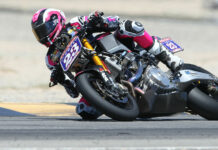From an FIM press release:
Road Racing World Championship Grand Prix
Changes to the Rules for the 2002 season
The main changes to the 2002 Road Racing World Championship Grand Prix Regulations, beside the introduction of 4-stroke prototypes up to 990cc in the MotoGP class (former 500cc class), are the following:
Sporting Regulations
-To replace “500cc” by “MotoGP” in the whole regulations. MotoGP class: 500cc 2-stroke/990cc 4-stroke.
– Riders in the MotoGP class must be in possession of a “FIM Grand Prix Super License”.
-The maximum age of new contracted riders participating in the 125cc Grand Prix for the first time and wild card riders is 25 years at 01.01.2002.
-All manufacturers must be in possession of the appropriate “FIM Manufacturers’ License”.
-No substitution or replacement of the entered rider may be made after 17h30 on the first day of the event (technical control), except in the case of the MotoGP class where substitutions may be made up until 12h00 on the second day of practice.
-Each Grand Prix host Federation (FMNR) may nominate 3 wild card entries for the 125cc and 250cc classes in their own Grand Prix.
-The MSMA may, at each Grand Prix event, nominate 1 wild card entry for the 250cc and MotoGP classes.
-The FIM may nominate 2 wild card entries for the 125cc and 250cc classes, and the FIM/Dorna may nominate 1 wild card entry for the MotoGP class at each MotoGP event.
-Timetable for Qualifying practice: 125cc: 13h15 to 13h45; MotoGP: 14h00 to 15h00; 250cc: 15h15 to 16h00.
-Practice restrictions: when there is a break in the Championship of two or more consecutive week-ends, then the exceptions will not apply from 9h00 on the Wednesday after the Grand Prix until the following Grand Prix. Winter testing for 125cc and 250cc teams will be restricted to their own continental zone (Europe – Americas – Asia/Oceania – Africa) or official IRTA tests.
-Starter engines may also be used on the grid. Number of persons for each rider on the grid: 7 for MotoGP; 3 minutes before the start: 2 mechanics for MotoGP.
-Only riders who have completed at least one sighting lap will be permitted to start the race from their position published on the final grid. Under no circumstances may they push their motorcycle onto the grid from the pit lane. Riders may complete more than one sighting lap by passing through the pit lane where they may make adjustments, change machines or refuel. Riders who do not go onto the grid may start the warm-up lap from the pit lane under the instructions of a marshal positioned at the pit lane exit. Such riders must have tyre warmers removed and may not change wheels after the display of the 3 minutes board. Riders starting the warm-up lap from the pit lane must start the race from the back of the grid. If there are two or more riders starting from the back of the grid, they will take up position in the order in which they qualified for the race.
-No signal of any kind may pass between a moving motorcycle and anyone connected with the motorcycle’s entrant or rider, save for the signal from the timekeeping transponder, from the on-board cameras, two way radio voice communication…
-Teams will compete for a MotoGP Team Championship; teams in the MotoGP class will be, in principle, be comprised of two riders. The names of the teams will be composed of three elements: the name of the manufacturer of the motorcycle or engine (mandatory), the name of the team (mandatory except when the team name is the same as the manufacturer) and the name of the main sponsor (optional). All points scored by both riders in the team, including substitutes or replacements, will count toward the Team Championship; in the case of a one rider team, only the points scored by that rider will count. Wild card riders do not score points.
-Entries; a rider shall be deemed to have taken part in the event when he participates in, at least, one practice session. A rider shall be deemed to have started a race when he participates in, at least, the first lap of the race.
-Finish of a race and race results: to be counted as a finish in the race and be included in the results, a rider must cross the finish line on the race track (not in the pit lane) within five minutes of the race winner. The rider must be in contact with his machine.
-The white line indicating the pole position must be painted 1 meter before the start line.
-As from 01.01.2003, races will not be stopped for changes in adhesion resulting from climatic changes.
Technical Regulations
-Helmets must be of the full face type and conform to one of the recognised international standards: Europe: ECE 22-04 & ECE 22-05 ‘p’ – Great Britain: BS 6658 Grade A – USA: DOT Federal Standard n° 218/SNELL M95 & M2000.
-Restrictions of materials: the basic structure of the crankshaft and camshafts must be made from steel or cast iron. Pistons, cylinder heads and cylinder blocks may not be composite structures which use carbon or aramid fibre reinforcing materials. Brake calipers must be made from aluminum material with a modulus of elasticity no greater than 80 Gpa. No parts of the bike or engine may be made from metallic materials which have a specific modulus of elasticity greater than 50 Gpa/(g/cm³).
FIM Announces Changes To 2002 World Championship Grand Prix Road Racing Rules
FIM Announces Changes To 2002 World Championship Grand Prix Road Racing Rules
© 2002, Roadracing World Publishing, Inc.






